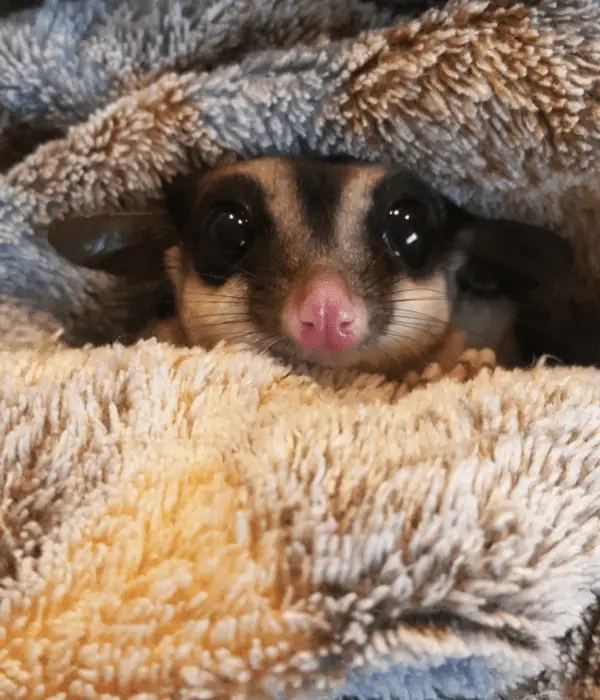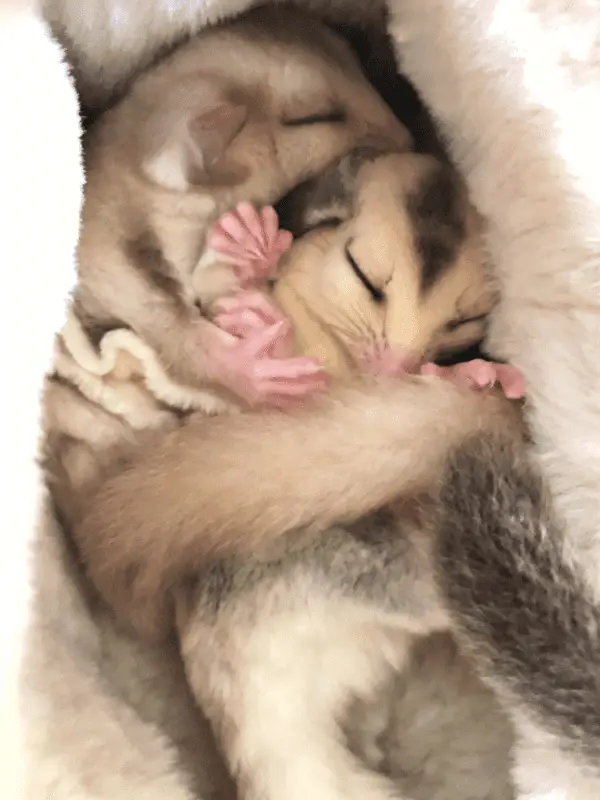This article contains affiliate links, and we may earn a commission at no cost to you if you choose to purchase through these links. I never recommend products that I do not trust or will not advise my veterinary clients and patients to use.
Unlike dogs, cats, and other domesticated species, sugar gliders have not evolved to live with humans. Therefore, they are wholly dependent on their owners to provide them with as close to a natural environment as possible. This is why we need to take clues from the natural habitat of sugar gliders to provide them with comfortable living conditions conducive to their overall health.
These little possums originate in tropical and cool-temperate forests where temperatures rarely ever go below freezing and ambient day and night temperatures do not fluctuate widely.
Sugar gliders should not be exposed to temperatures below 50°F (10°C) for extended periods. Due to their small body size and large body-surface-to-weight ratio, they quickly lose body heat in cold climates. During times of cold stress, they will enter a state of slowed metabolism and lowered core body temperature called torpor.
Torpor will be explained in more detail later in this article. But, first, let’s discuss the ideal environmental temperature for gliders and what sugar glider owners can do to help keep them comfortable during the winter months.

What Is The Ideal Temperature For Sugar Gliders?
Sugar Gliders can tolerate temperatures ranging from 60°F – 90°F (15°C – 32°C) but are most comfortable between 80°F – 88°F (27°C – 31°C). A Sugar Glider’s core body temperature is around 97°F (36°C). Sugar gliders can adjust their metabolic rate depending on the environmental temperature and the amount of food available.
You do not necessarily have to keep the room temperature strictly between the temperatures mentioned above, as some fluctuations in temperature can be tolerated. Instead, it would be best if you aimed to avoid long periods of temperature extremes that will negatively influence the health of your glider.
What Happens If My Sugar Glider Is Cold?
The cloacal temperature (temperature measured by inserting the tip of a small thermometer into the cloaca – the temperature your vet measures) of a sugar glider is around 90°F (32°C). A drop below 86°F (30°C) may indicate hypothermia. During a state of torpor, the body temperature may drop to 68°F (20°C).
Extreme temperatures cause physiological stress. Any type of stress over a prolonged time is detrimental to the health of any human or animal. Therefore, we should take measures to prevent the prolonged exposure to temperature extremes of our gliders.
Torpor
Torpor is a state of lower metabolism and resultant lowered body temperature to conserve energy. Sugar gliders enter a state of torpor when ambient temperatures are cold or when available food is limited (times of physiological stress).
Torpor can last 2-23 hours at a time but usually lasts 16 hours and occurs during daytime hours (gliders’ normal resting hours). The upper end of the time duration will only occur during extreme environmental circumstances such as cold or rainy conditions where foraging opportunities are limited.
A glider will adopt a curled-up posture with the tail covering the feet and face during torpor. Their metabolism is estimated to drop by 67% during this state.
Occasional torpor is not harmful to sugar gliders. On the contrary, it is a physiologic mechanism to aid survival during environmental extremes.
How Do I Know If My Sugar Glider Is Too Cold?
As a general rule, prolonged exposure (12 hours or more) to temperatures below 50°F (10°C) is too cold. Sugar gliders will shiver when they are too cold. You can place your hand on their pouch while they are sleeping to feel whether they are shivering.
You can also observe your sugar glider’s behavior to determine whether they are too cold. For example, if they are lethargic and stay curled up in a ball or cuddled together most of the day, or if they are not as active during the night and eat less than usual, they might be too cold.
If your glider spends most of the time outside of the pouch or prefers hanging out in a more drafty area in their enclosure, they are probably too hot.
Does A Sugar Glider’s Fur Prevent Them From Getting Cold?
Fur is a wonderful insulating jacket made by mother nature and can keep the wearer comfortable by preventing them from getting too hot in the summer and too cold in the winter.
Sugar gliders living in colder climates will grow thicker fur than those living in warmer climates. The extra layer of fur does help them to cope with colder climates but will not negate the effects of freezing temperatures, and additional heat sources will still need to be provided by owners.

How Do I Prevent My Sugar Glider From Getting Cold In Winter?
The biggest challenge for sugar glider owners during the winter months is to keep the ambient temperature in the room where their sugar gliders live at a comfortable level for their gliders, especially during nighttime when sugar gliders are most active.
Below are a few heating options that different glider owners in cold climates have found to be helpful to stave off the cold during the winter months.
1. Air conditioning
It is best to keep your gliders in one room that is kept at a comfortable temperature during the colder months. You may drop the temperature by a few degrees during the day if you need to conserve electricity or if you are at work, but make sure that the temperature is at a comfortable level for your glider from dusk till dawn, during their most active hours.
Aim to set the thermostat around 70 – 80 °F (21 – 28°C), depending on what you and your suggies find most comfortable.
Keep in mind that, provided that your home has good insulation, it may be more cost-effective to try and keep a room at a constant temperature than to switch the heating off and then on again at a later stage.
2. Oil Heater Near The Cage
An oil heater with a thermostat such as this one will be a safe heat source without excessively drying the air or the risks of overheating that some space heaters have.
Do not put a heater too close to the cage, as too much of the ‘dry heat’ emitted by the heater can be bad for your gliders.
3. Heated Pouches
A sleeping pouch with an added heating pad like this one can be a great temporary solution to keep your glider warm while they sleep during the day. The heating pad is in a separate compartment from the heating pad.
I will be hesitant to leave my glider in this pouch without supervision, but this can be a great alternative if you are around during a frigid day.
4. Snugglesafe
Snugglesafe is a microwaveable disc containing a heat-retaining gel that will provide a safe heat source that does not carry the risk an electric heat source does.
The only downside is that the snugglesafe will not hold its heat for an entire night if temperatures are below freezing.

5. Cover The Cage With Blankets
This might be an obvious option, but it becomes imperative to trap heat emitted from heat sources such as snugglingsafe inside the cage.
Do not underestimate the difference two or three layers of blankets can make to the ambient temperature inside a cage during a cold night!
6. Electric Heating Blankets
An electric heating blanket with a thermostat is a great option; however, you will need to make sure that there is no way that your gliders will be able to get to the heating blanket and chew on it. I suggest covering the cage with a thick blanket, followed by the heating blanket and then another thick blanket.
An alternative would be to place the heating blanket underneath the cage (like underfloor heating). This way, they will not be able to reach the blanket if the cage has a solid base. In addition, warm air travels upward so this will help to heat up the entire cage.
Covering the cage with an additional fleece blanket will help to keep warm air inside the cage, and providing pouches at different levels in the cage will allow your gliders to find a comfortable temperature spot in their enclosure.
7. Heat Rock
Heat Rocks can be a good source of constant heat. It will not reach temperatures that will be able to burn or harm your gliders. If you choose this as a heat source, make sure that there is no way that your gliders can reach the electric wires.
8. Heating Pad Under The Cage
A heating pad like this reptile heating pad stuck to the bottom of the cage and out of reach of the gliders can provide a good source of extra heat. These heating pads do not provide a tremendous amount of heat, though, and might not provide sufficient heat if this is the only heat source used in icy locations.
It is important to provide your gliders with different sleeping arrangement options at different levels close to and away from the heat source for them to be able to regulate their temperature and find a spot that is comfortable for them.
9. Get Your Sugar Glider A Friend
Gliders will happily huddle together during cold months. Therefore, if you keep a lone glider, you must check that they do not become too cold during the winter months.
As a general rule, gliders do better if kept with other gliders. If you live in a cold climate or are away for most of the day, I strongly suggest that you consider getting a companion for your sugar glider.
A Note On Temperature Adaptation
Provided that it is compatible with their physiology, our pets adapt to the temperatures they live in. This means that some gliders will do fine in slightly cooler temperatures if this is the environment they have been brought up in.
You might even find that your gliders’ fur will grow thicker during the winter months or that they lose more hair to adapt to the warmer summer temperatures.
As long as your glider is otherwise healthy, small fluctuations in temperatures or mean deviations from 60°F – 90°F (15°C – 32°C), will not cause your glider any harm.
Conclusions
Short times of temperature extremes will not be detrimental to the health of your glider. As long as they have access to an area protected from cold or hot temperatures, they can adapt to seasonal changes in temperature. However, it is imperative to remember that as sugar glider owners, our responsibility is to ensure that the ambient temperature is as comfortable as possible for our precious sugar gliders.
Resources
- Banks, R., 2013. Exotic small mammal care and husbandry. Hoboken: John Wiley, pp.81 – 92. https://onlinelibrary.wiley.com/doi/book/10.1002/9781119265405
- Dawson, Terence & May, Elizabeth. (1984). Daily variation in brain and body temperatures of the sugar glider (Petaurus breviceps): Some insights into the control of thermoregulation.
- Fleming, M., 1980. Thermoregulation and Torpor in the Sugar Glider, Petaurus Breviceps (Marsupialia:Petauridae). Australian Journal of Zoology, 28(4), p.521.
- Holloway, J., & Geiser, F. (2000). Development of thermoregulation in the sugar glider Petaurus breviceps (Marsupialia: Petauridae). Journal of Zoology, 252(3), 389-397. doi:10.1111/j.1469-7998.2000.tb00634.x
- Meredith, A. and Redrobe, S., 2002. BSAVA manual of exotic pets. 4th ed. Quedgeley: British Small Animal Veterinary Association, pp.13 – 25. https://www.researchgate.net/publication/240493099_The_BSAVA_Manual_of_Exotic_Pets_4th_edn
- O’Malley, B., 2005. Clinical anatomy and physiology of exotic species. Elsevier, pp.209 – 225. https://www.sciencedirect.com/book/9780702027826/clinical-anatomy-and-physiology-of-exotic-species
- Smith, A., 1982. Diet and Feeding Strategies of the Marsupial Sugar Glider in Temperate Australia. The Journal of Animal Ecology, 51(1), p.149.

